Photon Detector Technology for Laser Ranging: A Review of Recent Developments
Abstract
1. Introduction
2. Photodiodes
2.1. PIN-Type Photodiodes
2.2. Avalanche Diodes
3. Single-Photon Detectors
3.1. Photomultiplier Single-Photon Detectors
3.2. Single-Photon Avalanche Diodes
3.3. Superconducting Nanowire Single-Photon Detectors
4. Summary and Prospects
4.1. Summary
4.2. Future Prospects
Author Contributions
Funding
Conflicts of Interest
References
- Lloyd, D.R. What was measured in Millikan’s study of the photoelectric effect? Am. J. Phys. 2015, 83, 765–772. [Google Scholar] [CrossRef]
- Liu, Y. The application and optimization of phase method in laser distance measurement. In Journal of Physics: Conference Series; IOP Publishing: Bristol, UK, 2021; p. 022002. [Google Scholar]
- Rogalski, A. History of infrared detectors. Opto-Electron. Rev. 2012, 20, 279–308. [Google Scholar] [CrossRef]
- Kim, I.; Martins, R.J.; Jang, J.; Badloe, T.; Khadir, S.; Jung, H.-Y.; Kim, H.; Kim, J.; Genevet, P.; Rho, J. Nanophotonics for light detection and ranging technology. Nat. Nanotechnol. 2021, 16, 508–524. [Google Scholar] [CrossRef]
- Yin, Y.; Sun, J.; Huang, L.; Jiang, P.; Wang, X.; Ding, C. Moon imaging performance of FAST radio telescope in bistatic configuration with other radars. Remote Sens. 2023, 15, 4045. [Google Scholar] [CrossRef]
- Adams, B.W.; Elagin, A.; Frisch, H.; Obaid, R.; Oberla, E.; Vostrikov, A.; Wagner, R.G.; Wang, J.; Wetstein, M. Timing characteristics of large area picosecond photodetectors. In Nuclear Instruments and Methods in Physics Research Section A: Accelerators, Spectrometers, Detectors and Associated Equipment; Elsevier: Amsterdam, The Netherlands, 2015; Volume 795, pp. 1–11. [Google Scholar]
- Zhang, W.; You, L.; Li, H.; Huang, J.; Lv, C.; Zhang, L.; Liu, X.; Wu, J.; Wang, Z.; Xie, X. NbN superconducting nanowire single photon detector with efficiency over 90% at 1550 nm wavelength operational at compact cryocooler temperature. Sci. China Phys. Mech. Astron. 2017, 60, 120314. [Google Scholar] [CrossRef]
- Van Wolferen, H.A.; Abelmann, L. Laser interference lithography. In Lithography: Principles, Processes and Materials; Nova Publishers: Hauppauge, NY, USA, 2011; pp. 133–148. [Google Scholar]
- Zhang, H.; Long, M.; Deng, H.; Cheng, S.; Wu, Z.; Zhang, Z.; Zhang, A.; Sun, J. Developments of space debris laser ranging technology including the applications of picosecond lasers. Appl. Sci. 2021, 11, 10080. [Google Scholar] [CrossRef]
- Müller, J.; Murphy, T.W.; Schreiber, U.; Shelus, P.J.; Torre, J.-M.; Williams, J.G.; Boggs, D.H.; Bouquillon, S.; Bourgoin, A.; Hofmann, F. Lunar Laser Ranging: A tool for general relativity, lunar geophysics and Earth science. J. Geod. 2019, 93, 2195–2210. [Google Scholar] [CrossRef]
- Leach, J.; Fleming, F.; Paul, D.J.; Tan, C.H.; Ng, J.S.; Henderson, R.K.; Buller, G.S. Single-photon detection for long-range imaging and sensing. Optica 2023, 10, 1124–1141. [Google Scholar]
- Skompska, M. Hybrid conjugated polymer/semiconductor photovoltaic cells. Synth. Met. 2010, 160, 1–15. [Google Scholar] [CrossRef]
- Ferreira, M.F.; Castro-Camus, E.; Ottaway, D.J.; López-Higuera, J.M.; Feng, X.; Jin, W.; Jeong, Y.; Picqué, N.; Tong, L.; Reinhard, B.M.; et al. Roadmap on optical sensors. J. Opt. 2017, 19, 083001. [Google Scholar] [CrossRef]
- Veendrick, H.J. Nanometer CMOS ICs; Springer: Berlin/Heidelberg, Germany, 2017. [Google Scholar]
- Ma, H.; Luo, Y.; He, Y.; Pan, S.; Ren, L.; Shang, J. The short-range, high-accuracy compact pulsed laser ranging system. Sensors 2022, 22, 2146. [Google Scholar] [CrossRef] [PubMed]
- Hai, Y.; Li, Y.; Ma, X.; Zhao, X.; Zou, Y.; Hou, L.; Wang, D. Optical system design for small size laser ranging. In Proceedings of the 2015 International Conference on Optoelectronics and Microelectronics (ICOM), Changchun, China, 16–18 July 2015; pp. 115–118. [Google Scholar]
- Meng, Y.; Chen, W.; Li, W.; Zhao, Y.; Lu, C.; Cai, Y.; Chen, F.; Li, Z. Research on FPGA-based laser measuring instrument for surface flatness. In Proceedings of the 4th Optics Young Scientist Summit (OYSS 2020), Ningbo, China, 4–7 December 2020; pp. 349–357. [Google Scholar]
- Pellegrini, S.; Buller, G.S.; Smith, J.M.; Wallace, A.M.; Cova, S. Laser-based distance measurement using picosecond resolutiontime-correlated single-photon counting. Meas. Sci. Technol. 2000, 11, 712. [Google Scholar] [CrossRef]
- Petrie, G.; Toth, C.K. Introduction to laser ranging, profiling, and scanning. In Topographic Laser Ranging and Scanning; CRC Press: Boca Raton, FL, USA, 2018; pp. 1–28. [Google Scholar]
- Degnan, J.J. Scanning, multibeam, single photon lidars for rapid, large scale, high resolution, topographic and bathymetric mapping. Remote Sens. 2016, 8, 958. [Google Scholar] [CrossRef]
- Wehr, A. LiDAR systems and calibration. In Topographic Laser Ranging and Scanning; CRC Press: Boca Raton, FL, USA, 2018; pp. 159–200. [Google Scholar]
- Hawkins, A.R.; Schmidt, H. Handbook of Optofluidics; CRC Press: Boca Raton, FL, USA, 2010. [Google Scholar]
- Feng, L.-X.; Jiang, M.-S.; Bao, W.-S.; Li, H.-W.; Zhou, C.; Wang, Y. Controlling a sine wave gating single-photon detector by exploiting its filtering loophole. Chin. Phys. B 2018, 27, 080305. [Google Scholar] [CrossRef]
- Schaart, D.; Brunner, S. Bismuth Silicate as Detector Material for Top-Pet. Patent OCT-16-069. 2018. Available online: https://research.tudelft.nl/en/publications/bismuth-silicate-as-detector-material-for-top-pet (accessed on 3 July 2025).
- Yang, Y.; Wang, H.; Huang, Z.; Cao, Y.; Gui, H. A high resolution laser ranging system based on time-correlated single-photon counting technology. In Proceedings of the International Symposium on Optoelectronic Technology and Application 2014: Laser and Optical Measurement Technology; and Fiber Optic Sensors, Beijing, China, 13–15 May 2014; pp. 116–122. [Google Scholar]
- Gerardino, A.; Francardi, M.; Gaggero, A.; Mattioli, F.; Leoni, R.; Balet, L.; Chauvin, N.; Marsili, F.; Fiore, A. Nanophotonic technologies for single-photon devices. Opto-Electron. Rev. 2010, 18, 352–365. [Google Scholar] [CrossRef]
- Ren, M.; Gu, X.; Liang, Y.; Kong, W.; Wu, E.; Wu, G.; Zeng, H. Laser ranging at 1550 nm with 1-GHz sine-wave gated InGaAs/InP APD single-photon detector. Opt. Express 2011, 19, 13497–13502. [Google Scholar] [CrossRef]
- Luo, W.; Weng, Q.; Long, M.; Wang, P.; Gong, F.; Fang, H.; Luo, M.; Wang, W.; Wang, Z.; Zheng, D.; et al. Room-temperature single-photon detector based on single nanowire. Nano Lett. 2018, 18, 5439–5445. [Google Scholar] [CrossRef]
- Wang, W.; Jiang, Y.; Wang, C.; Li, X. Research Progress on Detection of Weak Light Signal by Photomultiplier Tube. In Proceedings of the 2021 International Conference on Advanced Electrical Equipment and Reliable Operation (AEERO), Beijing. China, 15–17 October 2021; pp. 1–5. [Google Scholar]
- Pichon, L.; Moignard, B.; Lemasson, Q.; Pacheco, C.; Walter, P. Development of a multi-detector and a systematic imaging system on the AGLAE external beam. Nucl. Instrum. Methods Phys. Res. Sect. B Beam Interact. Mater. At. 2014, 318, 27–31. [Google Scholar] [CrossRef]
- Doroud, K.; Rodriguez, A.; Williams, M.; Zichichi, A.; Zuyeuski, R. Comparative timing measurements of LYSO and LFS to achieve the best time resolution for TOF-PET. In Proceedings of the 2014 IEEE Nuclear Science Symposium and Medical Imaging Conference (NSS/MIC), Seattle, WA, USA, 8–15 November 2014; pp. 1–4. [Google Scholar]
- Ahlrichs, A.; Sprenger, B.; Benson, O. Photon counting and timing in quantum optics experiments. In Advanced Photon Counting: Applications, Methods, Instrumentation; Springer: Berlin/Heidelberg, Germany, 2015; pp. 319–341. [Google Scholar]
- Villa, F.; Markovic, B.; Bellisai, S.; Bronzi, D.; Tosi, A.; Zappa, F.; Tisa, S.; Durini, D.; Weyers, S.; Paschen, U.; et al. SPAD smart pixel for time-of-flight and time-correlated single-photon counting measurements. IEEE Photonics J. 2012, 4, 795–804. [Google Scholar] [CrossRef]
- He, Y.; Yu, C.; Yu, Y.; Bao, J.; Yang, B.; Li, X. Design and fabrication of integrated negative feedback resistor for InGaAs/InP avalanche photodiode. Infrared Phys. Technol. 2024, 142, 105566. [Google Scholar] [CrossRef]
- Tripathy, S.; Tyagi, K.; Pratap, P. A comparative study of various superconductors for Superconducting Nanowire Single Photon Detector applications. iScience 2024, 27, 110779. [Google Scholar] [CrossRef] [PubMed]
- Mazzillo, M.C.; Sanfilippo, D.N. Geiger-mode avalanche photodiode with high signal-to-noise ratio, and corresponding manufacturing process. U.S. Patent No. 9,105,789, 11 August 2015. [Google Scholar]
- Wang, F.-X.; Chen, W.; Li, Y.-P.; He, D.-Y.; Wang, C.; Han, Y.-G.; Wang, S.; Yin, Z.-Q.; Han, Z.-F. Non-Markovian property of afterpulsing effect in single-photon avalanche detector. J. Light. Technol. 2016, 34, 3610–3615. [Google Scholar] [CrossRef]
- Wang, X.; Tang, Z. Circular dichroism studies on plasmonic nanostructures. Small 2017, 13, 1601115. [Google Scholar] [CrossRef]
- Mccarthy, A.; Collins, R.J.; Krichel, N.J.; Fernandez, V.; Wallace, A.; Buller, G.S. Long-range time-of-flight scanning sensor based on high-speed time-correlated single-photon counting. Appl. Opt. 2009, 48, 6241–6251. [Google Scholar] [CrossRef] [PubMed]
- Ullrich, A.; Pfennigbauer, M. Linear LIDAR versus Geiger-mode LIDAR: Impact on data properties and data quality. In Laser Radar Technology and Applications XXI; SPIE: Bellingham, WA, USA, 2016; pp. 29–45. [Google Scholar]
- Du, B.; Pang, C.; Wu, D.; Li, Z.; Peng, H.; Tao, Y.; Wu, E.; Wu, G. High-speed photon-counting laser ranging for broad range of distances. Sci. Rep. 2018, 8, 4198. [Google Scholar] [CrossRef]
- Guan, Y.; Li, H.; Xue, L.; Yin, R.; Zhang, L.; Wang, H.; Zhu, G.; Kang, L.; Chen, J.; Wu, P. Lidar with superconducting nanowire single-photon detectors: Recent advances and developments. Opt. Lasers Eng. 2022, 156, 107102. [Google Scholar] [CrossRef]
- Guo, D.; Qu, Y.; Zhou, X.; Sun, J.; Yin, S.; Lu, J.; Liu, F. Research on Automatic Tracking and Size Estimation Algorithm of “Low, Slow and Small” Targets Based on Gm-APD Single-Photon LIDAR. Drones 2025, 9, 85. [Google Scholar] [CrossRef]
- Liang, Y.; Huang, J.; Ren, M.; Feng, B.; Chen, X.; Wu, E.; Wu, G.; Zeng, H. 1550-nm time-of-flight ranging system employing laser with multiple repetition rates for reducing the range ambiguity. Opt. Express 2014, 22, 4662–4670. [Google Scholar] [CrossRef] [PubMed]
- Xu, R.; Zheng, F.; Qin, D.; Yan, X.; Zhu, G.; Kang, L.; Zhang, L.; Jia, X.; Tu, X.; Jin, B.; et al. Demonstration of polarization-insensitive superconducting nanowire single-photon detector with Si compensation layer. J. Light. Technol. 2017, 35, 4707–4713. [Google Scholar] [CrossRef]
- Takeuchi, S. Photonic quantum information: Science and technology. Proc. Jpn. Acad. Ser. B 2016, 92, 29–43. [Google Scholar] [CrossRef]
- Natarajan, C.M.; Tanner, M.G.; Hadfield, R.H. Superconducting nanowire single-photon detectors: Physics and applications. Supercond. Sci. Technol. 2012, 25, 063001. [Google Scholar] [CrossRef]
- Hadfield, R.H. Single-photon detectors for optical quantum information applications. Nat. Photonics 2009, 3, 696–705. [Google Scholar] [CrossRef]
- Zhang, L.; Kang, L.; Chen, J.; Wu, P. Development of Superconductor Nanowire Single Photon Detector; Research Institute of Superconductor Electronics of Nanjing University: Nanjing, China, 2014. [Google Scholar]
- Hu, P.; Li, H.; You, L.; Wang, H.; Xiao, Y.; Huang, J.; Yang, X.; Zhang, W.; Wang, Z.; Xie, X. Detecting single infrared photons toward optimal system detection efficiency. Opt. Express 2020, 28, 36884–36891. [Google Scholar] [CrossRef]
- Esmaeil Zadeh, I.; Chang, J.; Los, J.W.; Gyger, S.; Elshaari, A.W.; Steinhauer, S.; Dorenbos, S.N.; Zwiller, V. Superconducting nanowire single-photon detectors: A perspective on evolution, state-of-the-art, future developments, and applications. Appl. Phys. Lett. 2021, 118, 190502. [Google Scholar] [CrossRef]
- Gu, M.; Kang, L.; Zhang, L.; Jia, T.; Wan, C.; Xu, R.; Yang, X.; Wu, P.; Witzigmann, B.; Osiński, M.; et al. High detection efficiency and rate superconducting nanowire single-photon detector with a composite optical structure. In Physics and Simulation of Optoelectronic Devices XXIII; SPIE: Bellingham, WA, USA, 2015; pp. 287–294. [Google Scholar]
- Lamb, R.A. A review of ultra-short pulse lasers for military remote sensing and rangefinding. Technol. Opt. Countermeas. VI 2009, 7483, 61–75. [Google Scholar]
- Zhou, G.; Zhou, X.; Song, Y.; Xie, D.; Wang, L.; Yan, G.; Hu, M.; Liu, B.; Shang, W.; Gong, C.; et al. Design of supercontinuum laser hyperspectral light detection and ranging (LiDAR)(SCLaHS LiDAR). Int. J. Remote Sens. 2021, 42, 3731–3755. [Google Scholar] [CrossRef]
- Xue, L.; Li, Z.; Zhang, L.; Zhai, D.; Li, Y.; Zhang, S.; Li, M.; Kang, L.; Chen, J.; Wu, P.; et al. Satellite laser ranging using superconducting nanowire single-photon detectors at 1064 nm wavelength. Opt. Lett. 2016, 41, 3848–3851. [Google Scholar] [CrossRef]
- Choquer, M. Surface Acoustic Waves Integrated with Solid-State Single Photon Sources and Superconducting Electronics; University of California: Santa Barbara, CA, USA, 2024. [Google Scholar]
- You, L. Superconducting nanowire single-photon detectors for quantum information. Nanophotonics 2020, 9, 2673–2692. [Google Scholar] [CrossRef]
- Kang, L.; Chen, J.; Zhang, L.; Wu, P.H. Superconducting nanowires for detecting single photons at telecommunication wavebands. In Proceedings of the 2010 3rd International Nanoelectronics Conference (INEC), Hong Kong, China, 3–8 January 2010; pp. 28–29. [Google Scholar]
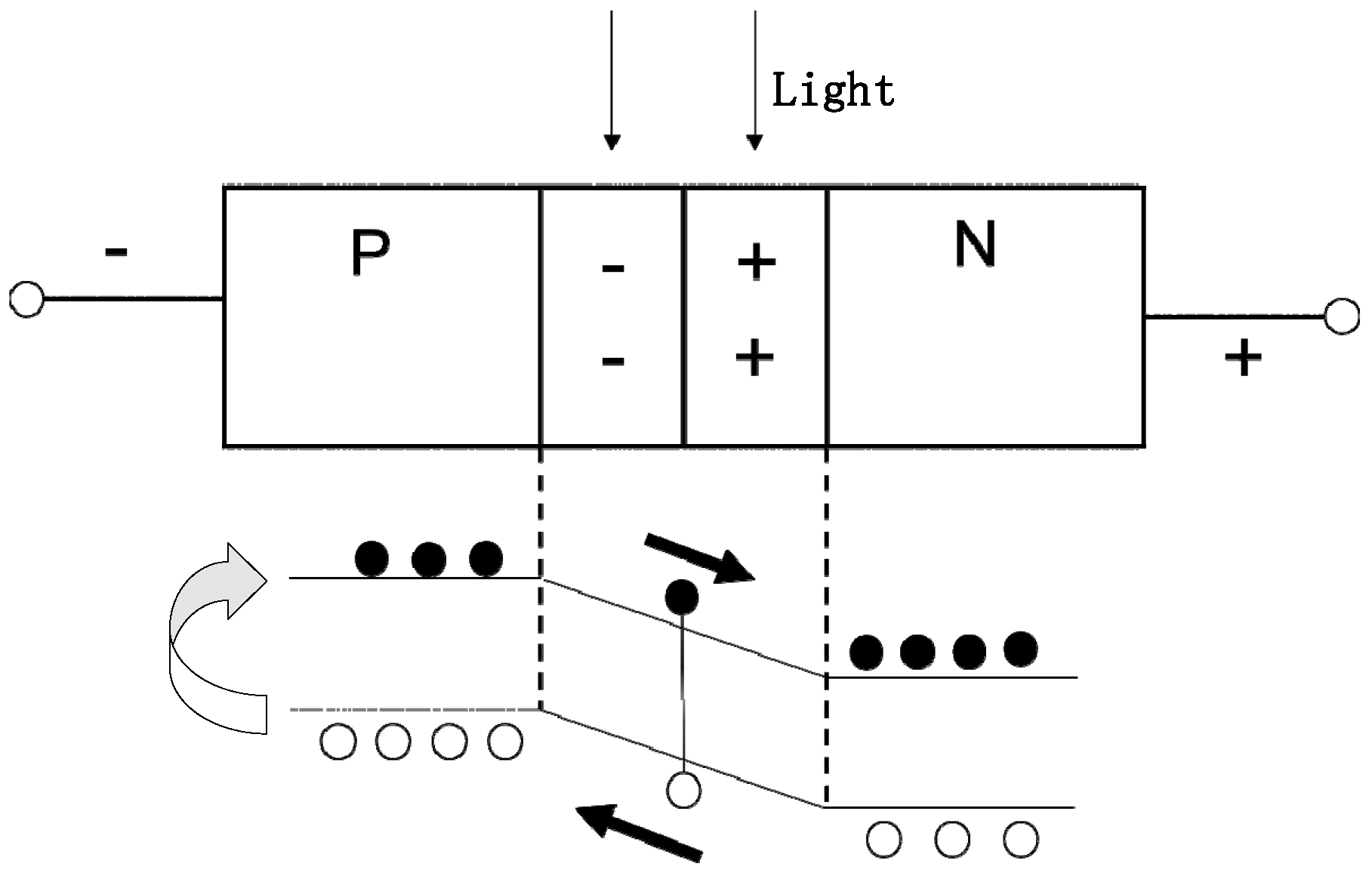
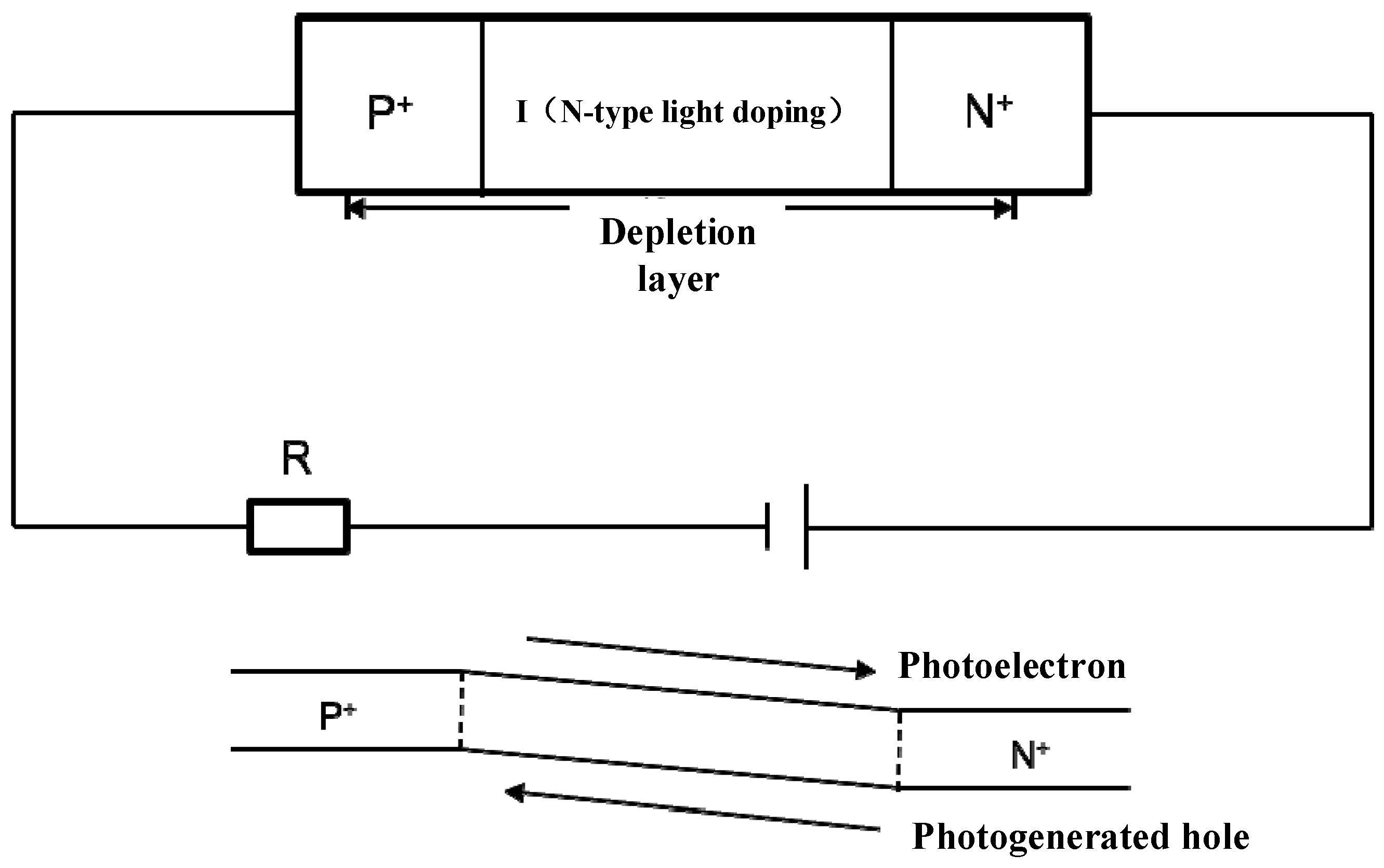
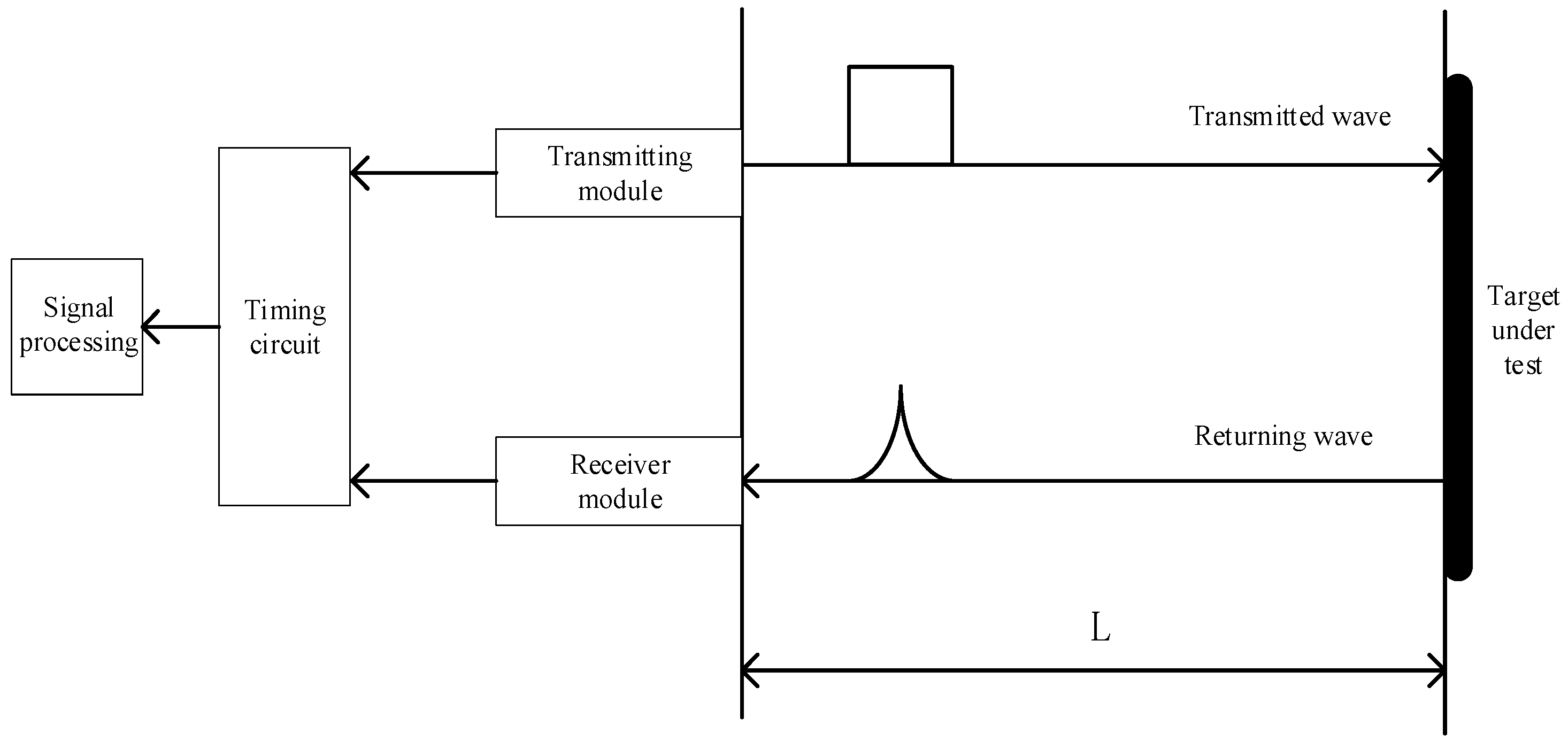
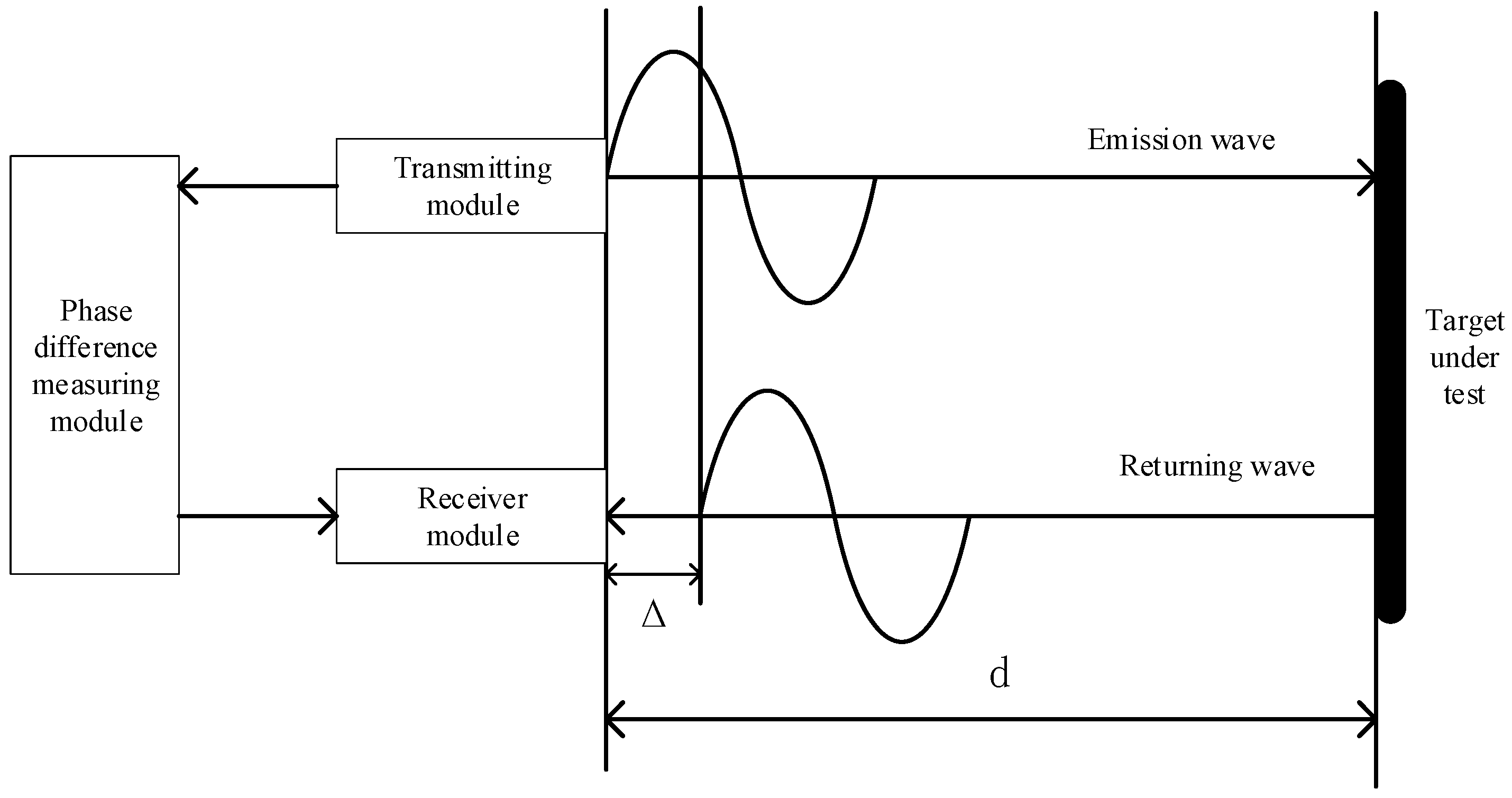
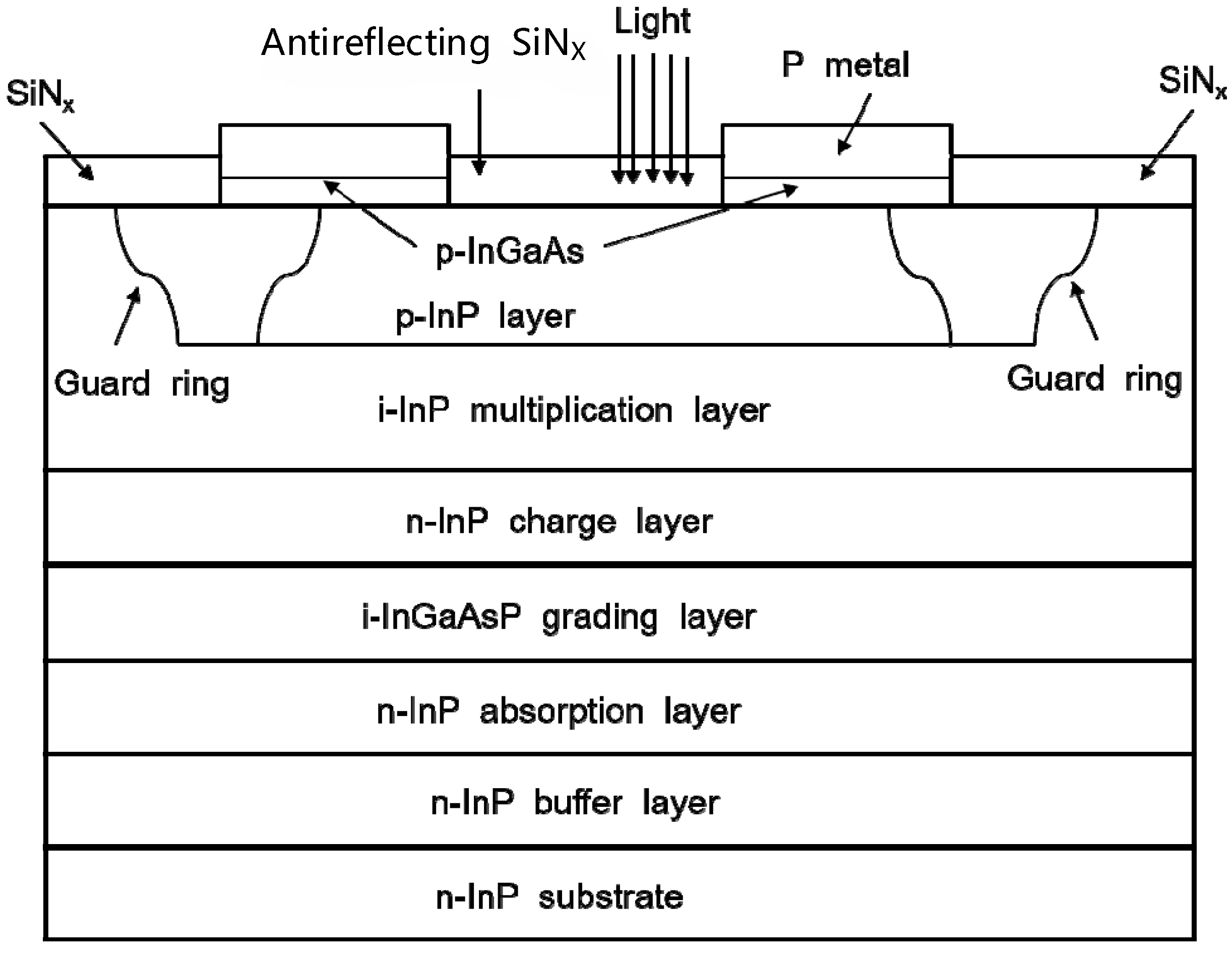

| Species | Peculiarities | Purpose |
|---|---|---|
| PN | The dark current is small, but the response speed is relatively low | Color sensor, phototriode, linear image sensor, spectrophotometer, camera exposure meter, etc. |
| PIN | High sensitivity, fast response speed, wide bandwidth, but the dark current is relatively large and there is low temperature sensitivity | Optical communication, optical fiber, remote control, high voltage rectifiers, RF and DC controlled microwave switches, photodetectors, photovoltaic cells, etc. |
| APD | Fast response and internal gain mechanism | High-speed optical communication, high-speed optical detection, laser rangefinder, positron emission tomography, and other fields |
| Components | Purpose |
|---|---|
| Glass bulb | Isolate the air and provide a vacuum working environment for the functional parts of the photomultiplier |
| Ceramic substrate | Fixed electron multiplier pole and photocathode, anode, and other parts |
| Photocathode | The photoelectric effect is used to convert photons into electrons |
| Electron multiplication system | The photoelectrons are multiplied and amplified by the principle of secondary electron emission |
| Anode | Accept the multiplied electrons and output them as a current |
| Resistor | The potential difference between adjacent electron doubling poles ensures that electrons can multiply between electron doubling poles |
| Name | Wavelength/nm | Detection Efficiency/% | Dark Count Rate/cps | Repetition Rate/MHz | Time Jitter/ps | Temperature/K | Refrigeration Method |
|---|---|---|---|---|---|---|---|
| NIST [47] | 1550 | 93 | 1 | 10 | 150 | 0.1 | Dilution refrigeration machine |
| MIT [48] | 1550 | 57 | 100 | 100 | 30 | 1.6 | Pulse tube chiller |
| NICT [48] | 1550 | 84 | 100 | 50 | 68 | 2.1 | Stirling refrigerator |
| SIMIT [7] | 1550 | 95 | 100 | 20 | 66 | 2.1 | Stirling refrigerator |
| USTC | 1550 | 92 | 0.1274 | 50 | <50 | 0.1 | Liquid helium + pulse tube refrigeration |
| NJU [49,50] | 1550 | 95 | 50 | 100 | 40 | 1.8 | Hybrid refrigeration system |
| JPL [51] | 1550 | 96 | 2 | 500 | 26.8 | 1.5 | Micro-pulse tube refrigeration machine |
Disclaimer/Publisher’s Note: The statements, opinions and data contained in all publications are solely those of the individual author(s) and contributor(s) and not of MDPI and/or the editor(s). MDPI and/or the editor(s) disclaim responsibility for any injury to people or property resulting from any ideas, methods, instructions or products referred to in the content. |
© 2025 by the authors. Licensee MDPI, Basel, Switzerland. This article is an open access article distributed under the terms and conditions of the Creative Commons Attribution (CC BY) license (https://creativecommons.org/licenses/by/4.0/).
Share and Cite
Li, Z.; Jin, X.; Yuan, C.; Wang, K. Photon Detector Technology for Laser Ranging: A Review of Recent Developments. Coatings 2025, 15, 798. https://doi.org/10.3390/coatings15070798
Li Z, Jin X, Yuan C, Wang K. Photon Detector Technology for Laser Ranging: A Review of Recent Developments. Coatings. 2025; 15(7):798. https://doi.org/10.3390/coatings15070798
Chicago/Turabian StyleLi, Zhihui, Xin Jin, Changfu Yuan, and Kai Wang. 2025. "Photon Detector Technology for Laser Ranging: A Review of Recent Developments" Coatings 15, no. 7: 798. https://doi.org/10.3390/coatings15070798
APA StyleLi, Z., Jin, X., Yuan, C., & Wang, K. (2025). Photon Detector Technology for Laser Ranging: A Review of Recent Developments. Coatings, 15(7), 798. https://doi.org/10.3390/coatings15070798








